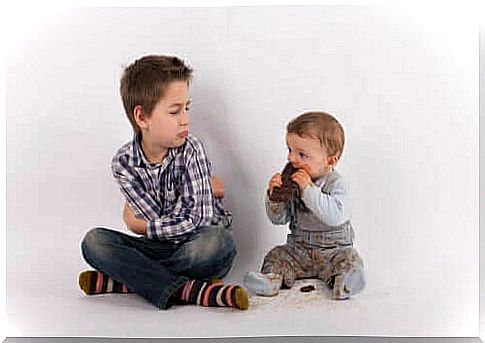The Most Common Problems In Children’s Emotional Development

All children experience one or more problems in their emotional development. These are a normal part of the development. However, if they are very frequent or worsen over time, they can lead to certain disorders and pathologies.
Sometimes children’s emotional problems are associated with behavioral disorders. Among them, we see poor performance in school, difficulties in social relationships and eating or sleeping disorders. Therefore, it is important that everyone in the family is on their guard so that they can prevent, detect and treat these emotional problems in a timely manner.
Problems in children’s emotional development
Emotions develop already when children are born. The emotional bond between a mother (and father!) And her baby greatly benefits the child’s social and emotional development. Emotions and how children process slowly build up the pillars that will shape their personality.
Still, all children will have one or more problems in their emotional development during their childhood. It is a normal part of their development. Here we take a look at the most common emotional problems.
Outbreak of rage
A tantrum is an immature way of expressing anger, discomfort or frustration. These outbreaks are normal from the age of 12 months and all the way up to three and four years of age.

Children act during an outburst of rage with anger, screaming or excessive crying. In fact, this is a form of communication that children use to express their unsatisfied desires or needs, because at 12-36 months they still do not know how to control their emotions.
Situations that can lead to tantrums in children
- Basic needs, such as hunger, thirst or sleep, that you can not meet at once.
- Need to ease the pressure and get rid of tensions, fears or frustrations that they are experiencing right now or have had to go through in the past.
- They feel that something is unfair or difficult to grasp.
- They are forced to do something they do not feel like doing or have to stop doing something they enjoy.
Around the age of 2, children discover how useful tantrums are. If a child has an outburst of rage and you immediately respond to his needs, the toddler learns that he has an effective tool for manipulating your emotions and getting what he wants. Therefore, it is best not to respond to tantrums motivated by a desire to get your attention or demand something.
When the child has calmed down, you should talk to her and make her understand that it does not help to get angry, cry or be kicked and fight to get what she wants. It is important to set boundaries and not let the child scream at what she wants. In time, the child will understand that the best way to get his will through is through dialogue and communication instead of tantrums.
But if the tantrum originates in a basic need, such as thirst, hunger or fatigue, you need to comfort the child, calm him down and hug her. You can act in the same way as if you see that your little one is scared or frustrated about something. First, you need to show empathy for her feelings and then divert the behavior and look for possible solutions.
Jealousy, one of the most common problems in children’s emotional development
Jealousy is an irrational reaction that consists of sadness, loss of self-esteem and feelings of envy towards another person. This is a normal evolutionary response to certain changes in a child’s environment.
Jealousy is usually not a major problem, whether the feelings last a long time or are only temporary. But if it affects their self-esteem, their social and emotional relationships or lasts longer than 5 years , jealousy can become a pathology.
Then jealousy can lead to behavioral problems such as aggression, insecurity or regression. It can also affect the child’s social relationships and give rise to emotions such as mistrust, stubbornness and envy.
In general, the main cause of jealousy in children is the arrival of a new sibling. The child may be affected if the emotional needs are not met as before and the child does not feel as loved and special.

However, there are other things that can evoke fears and feelings of losing their parents’ love in a child, for example:
- If the parents have favorites and prefer one of their children.
- The child is too dependent on a parent.
- Feelings of insecurity and difficulty adjusting.
To control and prevent jealousy, it is important that the family strengthens the child’s self-confidence and gives a lot of affection. It is also important that the parents are aware of their own behaviors to prevent the child from feeling less affectionate.
Regressions – a common problem in children’s emotional development
Sometimes children’s normal behavior changes. They can go backwards in their learning and maturity. For example, they may lose a skill they learned earlier. Other problems include starting to pee in bed again, talking in a childish way or asking to have your pacifier again.
These behaviors usually occur at about 3 to 4 years of age. This is normal and often occurs when a child has to deal with a change in their environment that causes stress. Regression can sometimes be a defense mechanism against trauma, conflict or any other emotionally difficult situation. Therefore, it is important not to get angry at the child. Regressions are usually transient, as it is a phase during which the child seeks emotional balance.
At the same time, however, it is important to identify the causes of the regression. This can help the child. No matter what, you should never get angry at the child, criticize her or try to make her ashamed of her behavior. It is best to show empathy, affection and devote more time to her.
The most common reasons for regression
- Changes in the child’s routine, such as a new caregiver or the child starting preschool.
- That the mother becomes pregnant or that a new sibling arrives.
- A more serious illness in the child or a family member.
- Death of a family member.
- Family conflicts or divorce from the parents.
- A recent or existing move to a new home.
Fears
Fear is a normal emotion that is part of a child’s development. It is an alarm system that helps the child to avoid potentially dangerous situations. The situations in which children experience fear vary depending on their stage of development.
For example, some fears may diminish with age while new ones seem to arise, as an adaptation to the changes in the world around them. These age-related fears are usually short-lived and short-lived. However, in some children these can become chronic and pathological.
Fears, by age
- During the first year, fears are usually linked to intense or unknown stimuli, such as loud noises and strangers.
- Up to the age of six, fears can be related to animals, storms, darkness, fantasy creatures (such as witches or ghosts), disasters and separations from parents.
- From the age of six, a child can fear physical harm or being teased or embarrassed.
- Later in life, it is common to be afraid of illnesses and accidents, to fail at school and conflicts with parents.
In general, physical fears, such as fears of animals, storms, and injuries, decrease with age, while social fears, such as ridicule, rejection, and public speaking, increase.
More about problems in children’s emotional development
If your child ever shows any of these problems in their emotional development, it is reasonable to assume that these are normal. They are part of the normal development. Therefore, you must always react to them with empathy and warmth, as long as these reactions are balanced. Excessive and overprotective affection can damage your child’s psychological development as much as lack of affection.









